Overview of artillery. Part of 7. Intelligence, surveillance and targeting systems
In the hands of the advanced observer of the Italian army, the Elbit PLDRII reconnaissance and target designation device used by many customers, including the Marine Corps, where it is designated AN / PEQ-17
In search of a goal
In order to work out the coordinates of the target, the data collection system must first of all know its own position. From it, she can determine the range to the target and the angle of the latter relative to the true pole. An observation system (preferably day and night), an accurate positioning system, a laser range finder, and a digital magnetic compass are typical components of such a device. It is also a good idea in such a system to have a tracking device capable of identifying a coded laser beam to confirm the target to the pilot, which, as a result, increases safety and reduces communication exchange. Pointers, on the other hand, are not powerful enough to guide weapons, but allow you to mark the target for ground or aviation (airborne) target designators, which ultimately direct the semi-active laser homing head of the ammunition to the target. Finally, radars for detecting artillery positions allow you to accurately determine the positions of enemy artillery, even if (and this is most often the case) they are not in line of sight. As it was said in the introductionIn this review, only manual systems will be considered.
In order to understand what the military wants to have in their hands, let's consider the requirements published by the American army in 2014 year for its laser reconnaissance and targeting device LTLM (Laser Target Location Module) II, which should eventually replace the armed previous version of the LTLM. The army expects a device weighing 1,8 kg (ultimately 1,6 kg), although the entire system, including the device itself, cables, tripod and lens cleaning kit, can raise the bar to 4,8 kg at best to 3,85 kg. If to compare, the current LTLM module has a base weight of 2,5 kg and a total weight of 5,4 kg. The target location error threshold is defined in 45 meters on 5 kilometers (as well as in LTLM), the practical circular probable deviation (CEP) of 10 meters on 10 km. For daytime operations, the LTLM II will have optics with a minimum magnification of x7, a minimum field of view 6 ° x3.5 °, an eyepiece scale with an increment of 10 mil, as well as a daytime color camera. It will provide streaming video and a wide field of view of 6 ° x4.5 °, guaranteeing the likelihood of recognizing 70% per 3,1 km and identification on 1,9 km in clear weather. The narrow field of view should be no more than 3 ° x2.25 °, and better than 2.5 ° x1.87 °, with appropriate 4,2 or 5 km recognition ranges and 2,6 or 3,2 km identification ranges. The thermal channel will have the same target fields of view with probability 70% recognition on 0,9 and 2 km and identification on 0,45 and 1 km. Target data will be stored in the UTM / UPS coordinate block, and data and images will be transmitted via RS-232 or USB 2.0 connectors. Power will be supplied from L91 AA lithium batteries. Minimum connectivity should be provided with a PLGR (Precision Lightweight GPS Receiver) high-precision GPS receiver and an advanced Defense Advanced GPS Receiver (DAGR) GPS receiver, as well as GPS systems being developed. However, the army would prefer a system that could also interact with the Pocket Sized Forward Entry Device pocket information input device, the Forward Observer Software / System advanced observer software, the Force XXI Battle Command battle management system, the Brigade-and-Below system and the network soldier system. Net Warrior.
BAE Systems offers two devices for reconnaissance and target designation. The UTB X-LRF is a development of the UTB X device, to which a Class 1 laser rangefinder with a range of 5,2 km has been added. The device is based on an uncooled thermal matrix size 640x480 pixel increments 17 microns, it may have optics with a focal distance 40, 75 and 120 mm with appropriate magnification x2.1, x3.7 and x6.6, diagonal field of view 19 °, 10.5 ° and 6.5 ° and electronic increase x2. According to BAE Systems, the range of positive (probability 80%) of the detection of a target of a NATO standard with an area of 0,75 X NUMX is respectively 2, 1010 and 2220 meters. The UTB X-LRF is equipped with an 2660 meter GPS system and a digital magnetic compass. It also includes a Class 2,5B laser pointer in the visible and infrared spectra. The device can store up to one hundred images in an uncompressed BMP format. Power is supplied from four L3 lithium batteries, which provide five hours of work, although the device can be connected to an external power source via the USB port. UTB X-LRF has a length of 91 mm, a width of 206 mm and a height of 140 mm, weighs 74 kg without batteries.
In the US Army, the Trigr device from BAE Systems is known as the Laser Target Locator Module, it includes an uncooled thermal imaging matrix and weighs less than 2,5 kg
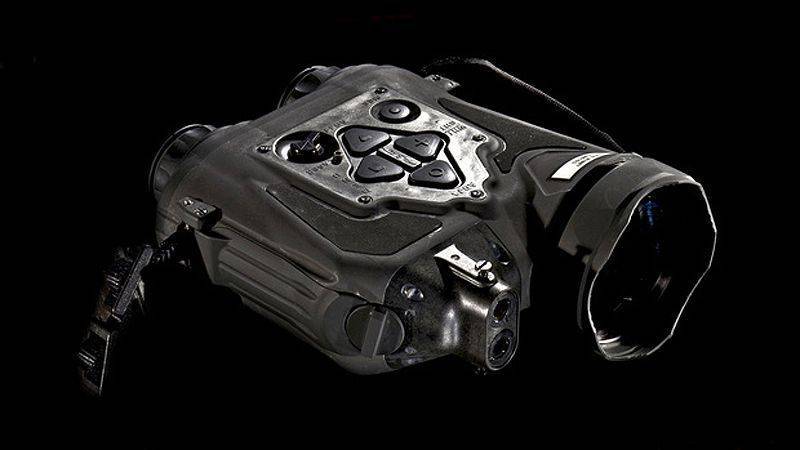
The UTB X-LRF device is a further development of the UTB X, a laser rangefinder has been added to it, which made it possible to turn the device into a complete reconnaissance, surveillance and target designation system
Another product from BAE Systems is the Trigr laser (Target Reconnaissance Infrared GeoLocating Rangefinder - a target infrared geolocation range finder) laser reconnaissance and targeting device developed in collaboration with Vectronix. BAE Systems provides the device with an uncooled thermal imager and a state-of-the-art, state-of-the-art, noise-free GPS receiver, while Vectronix provides x7 magnification optics, a fiber-optic laser range finder with a 5 km range and a digital magnetic compass. According to the company, the Trigr device guarantees the CER 45 meters at a distance of 5 km. The recognition range during the day is 4,2 km or more 900 meters at night. The device weighs less than 2,5 kg, two sets guarantee round-the-clock work. The entire system with tripod, batteries and cables weighs 5,5 kg. In the American army, the device received the designation Laser Target Locator Module; in 2009, a five-year contract was signed for an indefinite amount, plus two more in August, 2012, and January, 2013, worth 23,5 and 7 million dollars, respectively.
Northrop Grumman’s Markrop VII Mark VII handheld laser scanner has been replaced with an improved Mark VIIE instrument. This model received a thermal channel instead of the channel for enhancing the brightness of the image of the previous model. An uncooled sensor significantly improves visibility at night and in difficult conditions; it is distinguished by the field of view 11.1 ° x8.3 °. The day channel is based on front-view optics with x8.2 magnification and 7 ° x5 ° field of view. The digital magnetic compass provides accuracy ± 8 mil, the electronic clinometer has accuracy ± 4 mil, the location is provided by the built-in anti-interference module with selective accessibility of GPS / SAASM. The Nd-Yag laser rangefinder (a neodymium-yttrium-aluminum garnet laser) with optical parametric generation provides the maximum range of 20 km with an accuracy of ± 3 meter. The Mark VIIE device weighs 2,5 kg with nine CR123 commercial elements and is also equipped with an RS-232 / 422 data interface.
The newest product in the Northrop Grumman portfolio is the HHPTD (Hand Held Precision Targeting Device - hand-held, high-precision targeting device) device that weighs less than 2,26 kg. Compared to its predecessors, it has a daytime color channel, as well as a non-magnetic astronavigation module, which significantly improves accuracy to the level required by modern GPS-controlled ammunition. The contract to develop a device worth 9,2 million dollars was issued in January 2013, the work was carried out in collaboration with Flir, General Dynamics and Wilcox. In October, 2014 was tested on a White Sands missile test site.
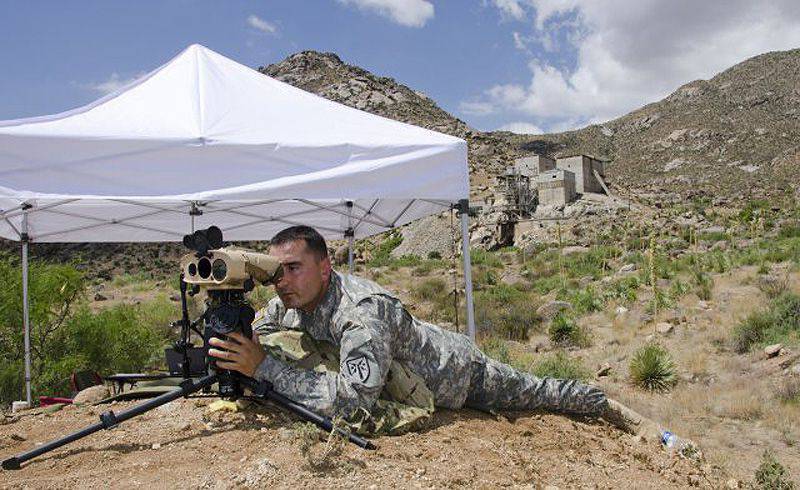
The Hand Held Precision Targeting Device is one of the latest developments from Northrop Grumman; his complex tests were conducted at the end of the year 2014
At Flir Recon B2 family of devices, the main channel is cooled thermal imaging. The B2-FO device with an additional day channel in the hands of an Italian commando (pictured)
Flir has several manual targeting devices in its portfolio and works with other companies to provide night vision devices for such systems. The Recon B2 device is distinguished by the main thermal imaging channel operating in the mid-IR range. The device with cooled matrix 640x480 on indium antimonide provides a wide field of view 10 ° x8 °, a narrow field of view 2.5 ° x1.8 ° and a continuous electronic increase x4. The thermal imaging channel is equipped with autofocus, automatic brightness gain control and digital data quality enhancement. The auxiliary channel can be equipped with either a day sensor (model B2-FO) or a long-wave infrared channel (model B2-DC). The first is based on a color 1 / 4 "color CCD camera with a 794x494 matrix with continuous x4 digital zoom and two of the same fields of view as in the previous model. The auxiliary thermal imaging channel is based on the 640 xNNXX microbolometer on vanadium oxide and provides one of the XNNXX on the vanadium oxide and one of the XNNXX microbolometer on the vanadium oxide and provides one of the visual field XNNXX on vanadium oxide and one XRNXXX microbolometer on vanadium oxide and provides one of the visual field XNNXX on vanadium oxide and one XRNXX microbolometer. x480 magnification. The B18 has a GPS C / A code module (Coarse Acquisition code is a coarse positioning code for objects) (however, a military standard GPS module can be built in to increase accuracy), a digital magnetic compass and 4 km distance rangefinder, as well as Class 2B laser pointer with 20 nanometer wavelength. The B3 can save up to 852 jpeg images that can be unloaded via USB or RS-2 / 1000 connectors, NTSC / PAL connectors are also available and HDMI for video recording. The device weighs less than 232 kg, including six lithium D batteries, providing four hours of continuous operation or more than five hours in energy-saving mode. Recon B422 can be equipped with a remote control kit, which includes a tripod, a panoramic rotator, power supply and communication unit and a control unit.
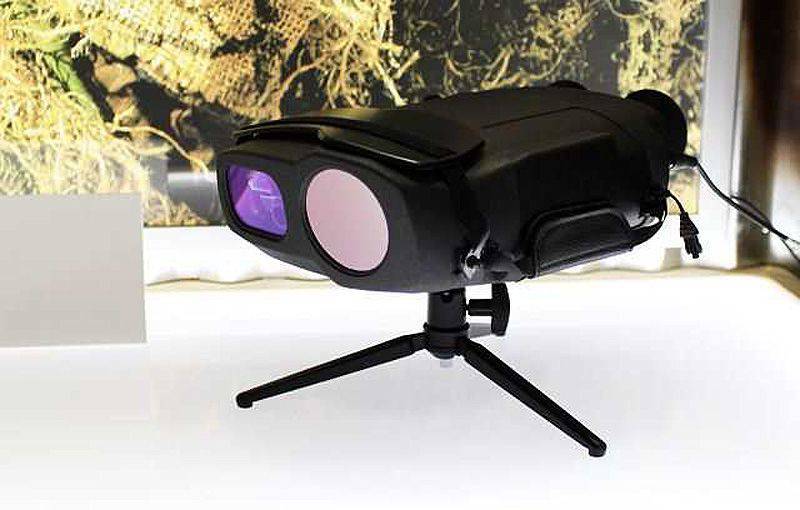
Flir offers a lighter version of the Recon V Surveillance and Targeting Instrument, which includes a thermal sensor, a range finder and other typical sensors packed in an 1,8 kg body.
The lighter model Recon B9-FO features an uncooled thermal imaging channel with a field of view of 9.3 ° x7 ° and a digital increase of x4. The color camera has a continuous magnification of x10 and a digital x4, while the characteristics of the GPS receiver, digital compass and laser pointer are the same as those of the B2 model. The main difference lies in the rangefinder, which has a maximum range of 3 km. The B9-FO is designed to operate at a shorter range; it also weighs significantly less than the B2 model, less than a 2,5 kg with two D batteries, which provide five hours of continuous operation.
Due to the absence of a daytime channel, the Recon V weighs even less, the entire 1,8 kg with batteries, which provide six hours of operation with the possibility of “hot” replacement. Its cooled matrix on indium antimonide with the size of 640x480 pixels works in the medium-wave infrared region of the spectrum, it has optics with x10 magnification (wide field of view 20 ° x15 °). The range finder is an instrument designed for a range of 10 km, while a gyroscope based on microelectromechanical systems provides image stabilization.
The French company Sagem offers three binocular solutions for day / night targeting. They all have the same color daytime channel with a 3 ° x2.25 ° field of vision, an eye-safe laser rangefinder on the 10 km, a digital magnetic compass with an azimuth of 360 ° and elevation angles ± 40 ° and a GPS C / S module with an accuracy of three meters (the device can be connected to an external GPS module). The main difference between the instruments lies in the thermal imaging channel.
The first on the list is Jim UC multifunctional binoculars, which have an uncooled 640x480 matrix with identical night and daytime fields of view, while a wide field of view is 8.6 ° x6.45 °. Jim UC is equipped with digital zoom, image stabilization, built-in photo and video recording; optional image fusion function between day and thermal channels. It also includes an eye-safe laser pointer with a wavelength of 0,8 μm plus analog and digital ports. Without batteries, the binocular weighs 2,3 kg. Rechargeable battery provides more than five hours of continuous operation.
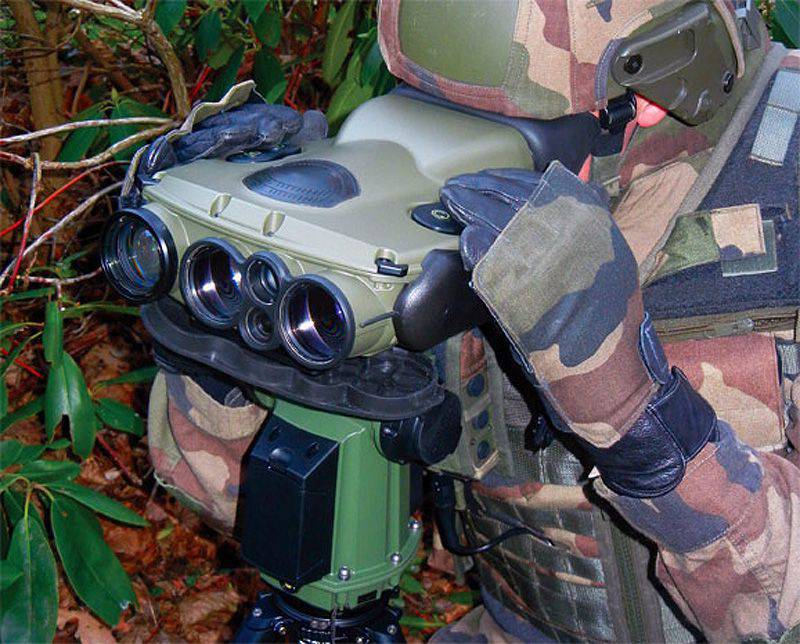
The multifunctional Jim Long Range binoculars of the French company Sagem were supplied to the French infantry as part of the Felin combat gear; On the photo, the binoculars are mounted on a Sterna targeting device from Vectronix.
Next comes the more advanced multi-function binoculars Jim LR, from which, by the way, the UC device “spun off”. He is in service with the French army, being part of the combat equipment of the French soldier Felin. Jim LR features a thermal imaging channel with a pixel sensor 320x240, operating in the 3-5 μm range; The narrow field of view is the same as that of the UC model, and the wide field of view is 9 ° x6.75 °. A more powerful laser pointer, which increases the range from 300 to 2500 meters, is offered as an option. The cooling system naturally increases the mass of Jim LR devices to 2,8 kg without batteries. However, the cooled thermal imaging module significantly improves the characteristics, detection range, recognition and identification of a person are respectively 3 / 1 / 0,5 km for the UC model and 7 / 2,5 / 1,2 km for the LR model.
The Jim HR multifunctional binoculars with even higher characteristics, which are provided by the high-resolution VGA 640x480 matrix, closes the model range.
Vectronix’s Sagem division offers two surveillance platforms that, when connected to Vectronix and / or Sagem systems, form extremely precise modular targeting tools.
The digital magnetic compass included in the GonioLight digital monitoring station provides 5 mil accuracy (0,28 °). By connecting a gyroscope with a true (geographic) pole orientation, the accuracy is increased to 1 mil (0,06 °). A 4,4 kg gyroscope is installed between the station itself and the tripod, with the result that the total weight of the GonioLight, gyroscope and tripod tends to the 7 kg. Without a gyroscope, such accuracy can be achieved through the use of embedded procedures for topographic referencing using known landmarks or celestial bodies. A GPS module and an access channel to an external GPS module are built into the system. The GonioLight station is equipped with an illuminated screen and has interfaces for computers, communications and other external devices. In case of a malfunction in the system, there are auxiliary scales for determining the direction and vertical angle. The system allows you to accept various day or night surveillance devices and range finders, such as the Vector rangefinder family or the Sagem Jim binoculars described above. Special mounts at the top of the GonioLight station also allow you to install two optical-electronic subsystems. The total mass varies from 9,8 kg in GLV configuration, including GonioLight plus Vector rangefinder, to 18,1 kg in GL G-TI configuration, which includes GonioLight, Vector, Jim-LR and gyroscope. The GonioLight monitoring station was developed at the beginning of the 2000s, and since then more than 2000 of these systems have been supplied to many countries. This station was also used in the fighting in Iraq and Afghanistan.
Vectronix’s experience helped it develop the Sterna ultra-light, non-magnetic targeting system. If GonioLite is intended for distances over 10 km, then Sterna is for 4-6 km ranges. Together with a tripod, the system weighs about 2,5 kg, accuracy is less than 1 mil (0,06 °) at any latitude using well-known landmarks. This results in a target position error of less than four meters at a distance of 1,5 km. In case of unavailability of landmarks, the Sterna system is equipped with a hemispherical resonant gyroscope jointly developed by Sagem and Vectronix, which ensures 2 mil accuracy (0,11 °) in determining true north to 60 ° latitude. The installation and orientation time is less than 150 seconds, and a rough alignment of ± 5 ° is required. The Sterna device is powered by four CR123A elements providing 50 orientation operations and 500 measurements. Like GonlioLight, the Sterna system can accept various types of optical-electronic systems. For example, the Vectronix portfolio contains the lightest device weighing less than 3 kg PLRF25C and a slightly heavier (less than 4 kg) Moskito. Vector or Jim devices can be added to perform more complex tasks, but the weight increases to 6 kg. The Sterna system has a special attachment point for mounting on a vehicle axle, from which it can be quickly removed for dismounted operations. To assess these systems in large quantities were supplied to the troops. The US Army ordered Vectronix handheld systems and Sterna systems as part of the Manual for High-precision Targeting Devices, released in July of 2012. Vectronix speaks with confidence about the continuous growth of Sterna sales in 2015.
In June 2014 of the year, Vectronix showed a Moskito TI observation and targeting device with three channels: daytime optical with x6 magnification, optical (CMOS technology) with increased brightness (both with 6.25 ° field of view) and uncooled 12 ° thermal imaging. The device also includes a rangefinder on 10 km with an accuracy of ± 2 meters and a digital compass with accuracy in azimuth ± 10 mil (± 0,6 °) and elevation ± 3 mil (± 0,2 °). The GPS module is optional, although there is a connector for external civilian and military GPS receivers, as well as Galileo or GLONASS modules. It is possible to connect a laser pointer. The Moskito TI device has RS-232, USB 2.0 and Ethernet interfaces, Bluetooth wireless connectivity is optional. It is powered by three CR123A batteries or batteries, providing over six hours of trouble-free operation. And finally, all of the above systems are packaged in a device with dimensions of 130x170x80 mm weighing less than 1,3 kg. This new product is a further development of the Moskito model, which, with a mass of 1,2 kg, has a day channel and a channel with enhanced brightness, a laser rangefinder with a range of 10 km, a digital compass; Optionally possible to integrate a GPS civil standard or connect to an external GPS receiver.
Thales offers a full range of intelligence, surveillance and targeting systems. The Sophie UF system with a mass of 3,4 kg has an optical day channel with an increase of x6 and a field of view of 7 °. The range of the laser rangefinder reaches 20 km, the Sophie UF can be set with a GPS receiver P (Y) code (encrypted code for the exact location of the object) or C / A code (coarse positioning code for objects) that can be connected to an external DAGR / PLGR receiver. A magnetoresistive digital compass with an accuracy of 0,5 ° in azimuth and an inclinometer with a gravity sensor with an accuracy of 0,1 ° complete the sensor set. The device is powered by AA elements that provide 8 hours of operation. The system can operate in the modes of correction of projectile fall and target data reporting; RS232 / 422 connectors for exporting data and images. The Sophie UF system is also in service with the British army under the designation SSARF (Surveillance System and Range Finder).
Moving from simple to complex, we will focus on the Sophie MF device. It consists of a cooled 8-12 μm thermal imager with wide 8 ° x6 ° and narrow 3.2 ° x2.4 ° fields of view and digital zoom x2. As an option, there is a color day channel with a field of view 3.7 ° x2.8 ° along with a laser pointer with a wavelength of 839 nm. The Sophie MF system also includes a 10 km laser rangefinder, a built-in GPS receiver, a connector for connection to an external GPS receiver, and a magnetic compass with an accuracy of 0,5 ° azimuth and 0,2 ° elevation angle. Sophie MF weighs 3,5 kg and runs on a battery pack for more than four hours.
The Sophie XF is almost identical to the MF model, the main difference is the thermal imaging sensor, which operates in the mid-wave (3-5 μm) IR spectrum and has a wide 15 ° x11.2 ° and narrow 2.5 ° x1.9 ° field of view, optical magnification x6 and electronic increase x2. Analog and HDMI outputs are available for video output, as Sophie XF can store up to 1000 photos or up to 2 GB of video. There are also RS 422 and USB ports. The XF model has the same dimensions and weight as the MF model, although the battery life is slightly more than six or seven hours.
The British company Instro Precision, specializing in goniometers and panoramic heads, has developed a modular Gyro Target Acquisition System (MG-TAS) modular intelligence and targeting system, which allows you to perform high-precision determination of the true pole. The accuracy is less than 1 mil (independent of magnetic interference), and the digital goniometer offers 9 accuracy mil depending on the magnetic field. The system also includes a light tripod and a hardened handheld computer with a complete set of targeting tools for calculating target data. The interface allows you to install one or two sensors targeting.
Vectronix developed the Sterna light non-magnetic reconnaissance and targeting system, which has a range from 4 to 6 kilometers (pictured on Sagem Jim-LR)
The latest addition to the family of targeting devices is the Vectronix Moskito 77 model, which has two daytime and one thermal imaging channel
Thales Sophie XF device allows you to determine the coordinates of the target, and for the night view there is a sensor operating in the mid-IR region of the spectrum
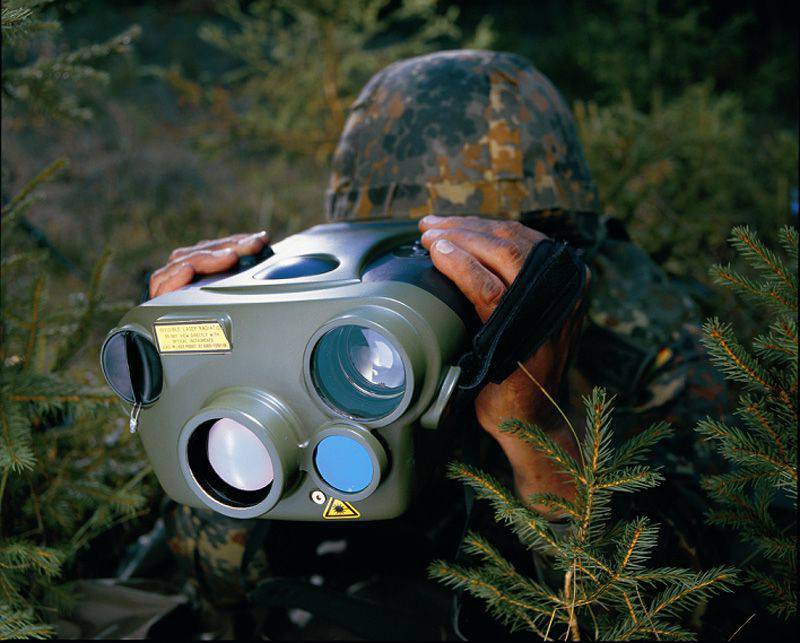
The Nestor system of Airbus DS with a cooled thermal imaging matrix and 4,5 kg mass was developed for German mountain rifle troops. It is in service with several armies.
Airbus DS Optronics offers two Nestor and TLS-40 reconnaissance, surveillance and targeting instruments, both manufactured in South Africa. The Nestor, which began production in the 2004-2005 years, was originally developed for German mountain rifle units. The 4,5 biocular system of kg includes a day channel with an increase of x7 and a field of view 6.5 ° with an increment of the 5 sighting threads mil, as well as a thermal channel based on a cooled matrix of pixels 640x512 pixels with two fields of view, a narrow 2.8 ° x2.3 ° and a wide x (XNXXXX11.4 ° and a wide x (XNXXXXXXXX9.1 pixels) and two fields of view, a narrow 1 ° x20 ° and a wide x (XNXXXXX5) pixels (1XXXXXXXXXXXXNXXXXXXNXXXXXNXXXXXXXXXXXXXXXXXXXXXXXXXXXXXXXXXXXXXXXXXXXXXXXXXXXXXXXXXXXXXXXXXXXXXXXXMX of mil °). The distance to the target is measured by a Class 0.5M laser rangefinder with a range of 45 km and an accuracy of ± 12 meters and an adjustment of the gating (pulse repetition rate) in range. The direction and elevation angle of the target provides a digital magnetic compass with an azimuth accuracy of ± 1 ° and an elevation angle of ± 10 °, with a measurable elevation angle of + 32 °. The Nestor has a built-in 2015-channel GPS receiver LXNUMX C / A (coarse definition), you can also connect external GPS modules. There is a CCIR-PAL video output. The device is powered by lithium-ion batteries, but it is possible to connect to an external DC power source on XNUMX-XNUMX Volt. The cooled thermal imager increases the mass of the system, but at the same time the night vision capabilities increase. The system is in service with several European armies, including the Bundeswehr, several European border forces, and unnamed buyers from the Middle and Far East. The company expects several large contracts for hundreds of systems in XNUMX, but new customers are not named there.
Using the experience gained in creating the Nestor system, Airbus DS Optronics has developed a lighter Opus-H system with an uncooled thermal imaging channel. Deliveries began in 2007. It has the same daily channel, while the 640x480 microbolometric matrix provides the 8.1 ° x6.1 ° field of view and the ability to save images in jpg format. Other components were left unchanged, including a monopulse laser range finder, which not only increases the measurement range without the need for stabilization on a tripod, but also detects and shows up to three targets at any range. Also from the previous model left serial connectors USB 2.0, RS232 and RS422. Eight AA elements provide power supply. The Opus-H weighs about one kg less than the Nestor, and is also smaller in size, 300x215x110 mm compared to 360x250x155 mm. Buyers of the Opus-H system from military and paramilitary structures were not disclosed.
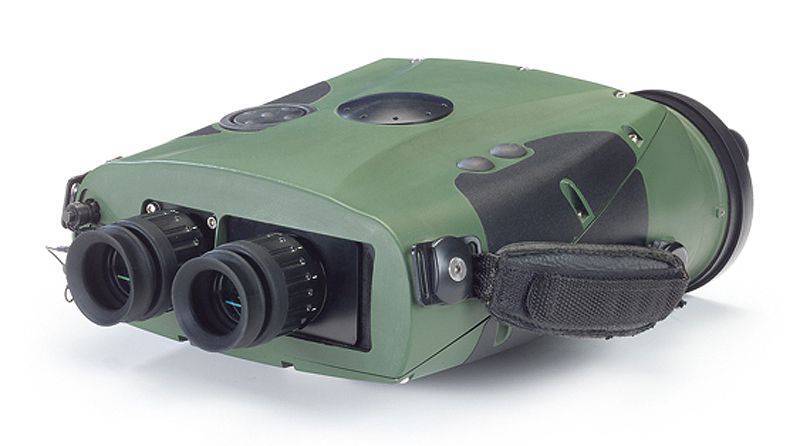
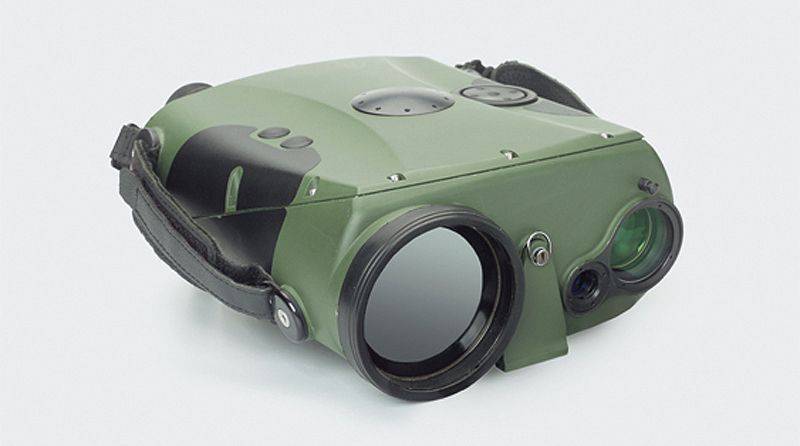
Airbus DS Optronics Opus-H System
Due to the growing need for light and cheap targeting systems, Airbus DS Optronics (Pty) has developed a series of TLS 40 instruments that weigh less than 2 kg with batteries. Three models are available: TLS 40 with only day channel, TLS 40i with enhanced image brightness and TLS 40IR with uncooled thermal imaging matrix. Their laser range finder and GPS are the same as that of the Nestor. The digital magnetic compass operates in the range of vertical angles ± 45 °, cross slope angles ± 30 ° and provides accuracy in azimuth ± 10 mil and in elevation ± 4 mil. The biocular daytime optical channel, common with the previous two models, with the same reticle, as in the Nestor instrument, has an x7 magnification and an 7 ° field of view. The option to increase the brightness of the TLS 40i image has a monocular channel based on a Photonis XR5 tube with an increase in x7 and a field of view 6 °. The TLS 40 and TLS 40i models have the same physical characteristics, their dimensions are 187x173x91 mm. With the same mass as the other two models, the TLS 40IR device is larger in size, 215x173x91 mm. It has a monocular diurnal canal with the same magnification and a slightly larger 6 ° field of view. The 640x312 microbolometer array provides an 10.4 ° x8.3 ° field of view with digital zoom x2. The image is displayed on a black and white oled-display. All TLS 40 models can optionally be equipped with a daytime camera with a 0.89 ° x0.75 ° field of view to capture jpg images and a voice recorder to record voice comments in WAV format for 10 seconds per image. All three models are powered by three CR123 batteries or from an external power supply to the 6-15 Volts, have USB 1.0, RS232, RS422 and RS485 serial connectors, PAL and NTSC video outputs, and can also be equipped with an external GPS receiver. The TLS 40 series has already entered service with unnamed customers, including African ones.
The Nyxus Bird Gyro differs from the previous Nyxus Bird model in a gyroscope for orientation to the true pole, which significantly improves the accuracy of determining the coordinates of the target at large distances.
The German company Jenoptik has developed a day-night reconnaissance, surveillance and targeting system Nyxus Bird, which is available in medium and long-range versions. The difference lies in the thermal channel, which in the medium range version is equipped with a lens with a field of view 11 ° x8 °. The detection, recognition and identification ranges of the standard NATO target are respectively 5, 2 and 1 km. The long-range version with optics with a field of view 7 ° x5 ° provides long ranges, respectively 7, 2,8 and 1,4 km. The matrix size for both variants is 640x480 pixels. The daily channel of the two options has a field of view 6,75 ° and an increase of x7. The Class 1 laser rangefinder has a typical 3,5 km range, a digital magnetic compass provides accuracy in azimuth 0,5 ° in the 360 ° sector and in the elevation angle 0,2 ° in the 65 ° sector. The Nyxus Bird is characterized by several measurement modes and can store up to 2000 infrared images. Having a built-in GPS module, however, it can be connected to the PLGR / DAGR system to further improve accuracy. To transfer photos and videos, there is a USB connector 2.0, Bluetooth wireless connection is optional. With a lithium battery on a 3 Volt, the device weighs 1,6 kg, without an eyecup the length is 180 mm, the width 150 mm and the height 70 mm. Nyxus Bird is part of the IdZ-ES German modernization program. The addition of a tactical Micro Pointer computer with an integrated geographic information system significantly increases the possibility of localizing targets. Micro Pointer is powered by internal and external power sources, has RS232, RS422, RS485 and USB connectors and an optional Ethernet connector. This small computer (191x85x81 mm) weighs only 0,8 kg. Another additional system is a gyroscope for a non-magnetic orientation to the true pole, which provides very accurate direction and precise coordinates of the target at all ultra-long distances. A gyro head with the same connectors as the Micro Pointer can be connected to an external GPS PLGR / DAGR system. The four CR123A elements provide 50 orientation operations and 500 measurements. The head weighs 2,9 kg, and the whole system weighs with a tripod kg 4,5.
The Finnish company Millog has developed a manual targeting system Lisa, which includes an uncooled thermal imager and an optical channel with ranges of detection, recognition and identification of the vehicle 4,8 km, 1,35 km and 1 km, respectively. The system weighs 2,4 kg with batteries that provide 10 hours of operation. After receiving the contract in May 2014, the system began to enter into service with the Finnish army.
Developed several years ago by Selex-ES for the Soldato Futuro Italian Army soldier modernization program, Linx’s multi-functional manual day / night reconnaissance and targeting device has been improved and currently has an uncooled 640x480 matrix. A thermal imaging channel has an 10 ° x7.5 ° field of view with x2.8 optical zoom and x2 and x4 electronic zoom. Daytime channel is a color camera with two magnifications (x3.65 and x11.75 with corresponding fields of view 8.6 ° x6.5 ° and 2.7 ° x2.2 °). A programmable electronic crosshair is built into the color VGA display. Distance measurement is possible up to 3 km, the location is determined using the built-in GPS receiver, while the digital magnetic compass provides azimuth information. Export images via a USB connector. Further development of the Linx device is expected during the 2015 year, when miniature cooled sensors and new functions will be built into it.
In Israel, the military seeks to increase their fire interaction capabilities. To this end, each battalion will be given a group of coordination of air strikes and ground fire support. Currently, one artillery liaison officer is attached to the battalion. National industry is already working to provide the tools for this task.
The Lisa device of the Finnish company Millog is equipped with uncooled thermal and daytime channels; with a mass of just 2,4 kg, it has a detection range of just under 5 km
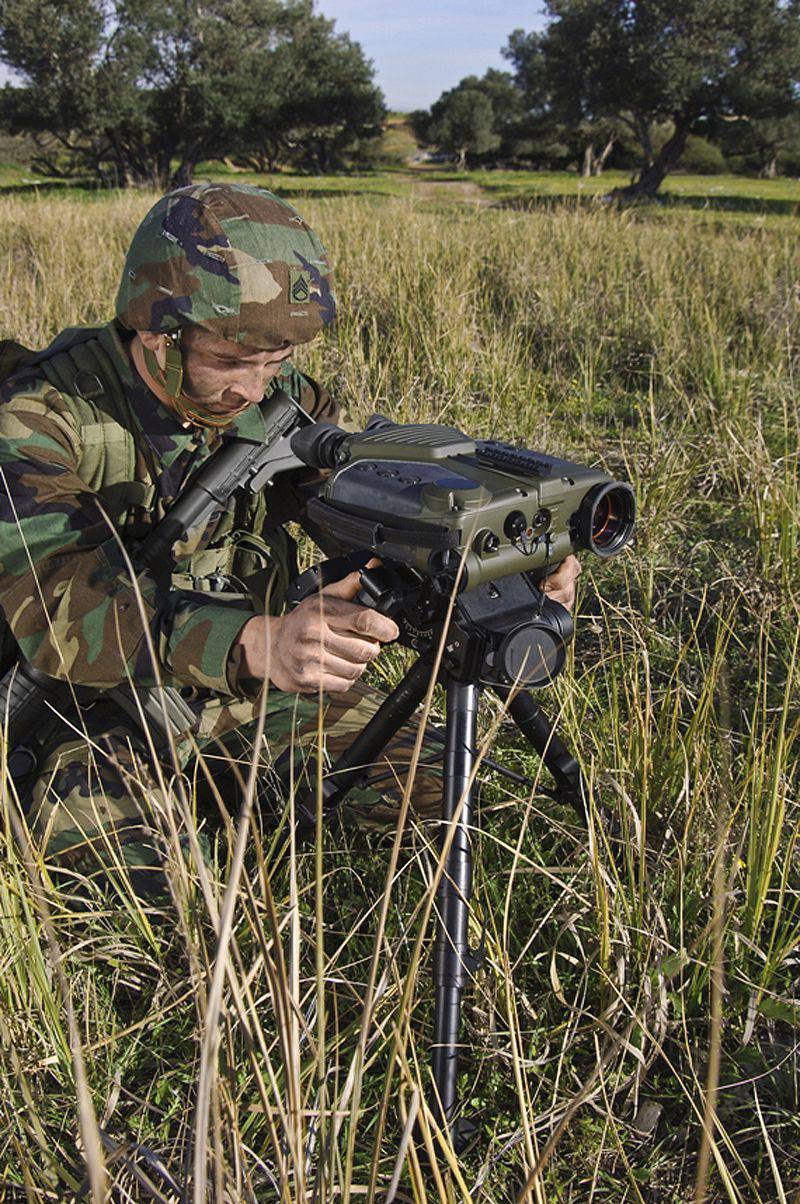
The device Coral-CR with a cooled thermal imaging channel is included in the line of target designation systems of the Israeli company Elbit
Elbit Systems is very active in both Israel and the United States. Its Coral-CR surveillance and intelligence device has a cooled medium-wave 640x512 detector on indium antimonide, which has optical fields of view from 2.5 ° x2.0 ° to 12.5 ° x10 ° and digital magnification x4. A black and white CCD camera with fields of view from 2.5 ° x1.9 ° to 10 ° x7.5 ° works in the visible and near-IR spectral regions. Images are displayed on a high resolution color oled display through customizable binocular optics. An eye-safe Class 1 laser rangefinder, built-in GPS and a digital magnetic compass with 0.7 ° accuracy in azimuth and elevation complete the touch-screen kit. The coordinates of the target are calculated in real time and can be transmitted to external devices, the device can save up to 40 images. There are CCIR or RS170 video outputs. The Coral-CR has a length of 281 mm, a width of 248 mm, a height of 95 mm and a mass of 3,4 kg, including an ELI-2800E rechargeable battery. The device is in service with many NATO countries (in America under the designation Emerald-Nav).
Mars uncooled thermal imager is lighter and cheaper, based on a vanadium oxide 384x288 detector. In addition to the 6 ° x4.5 ° and 18 ° x13.5 ° thermal imaging channel, it has a built-in color day camera with 3 ° x2.5 ° and 12 ° x10 ° fields of vision, a laser range finder, a GPS receiver and a magnetic compass. The Mars device has a length of 200 mm, a width of 180 mm and a height of 90 mm, with a battery it weighs only 2 kg.
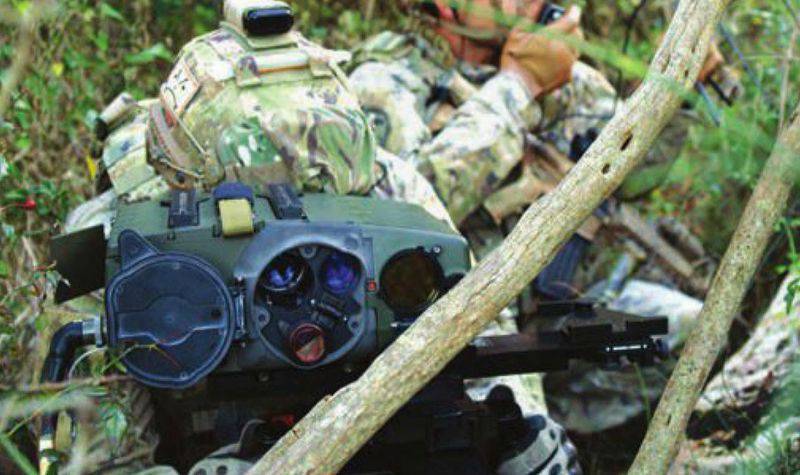
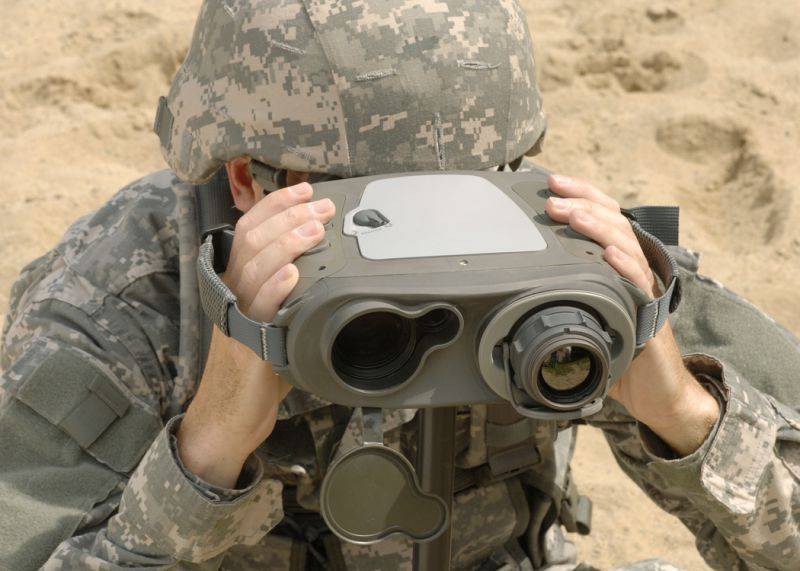
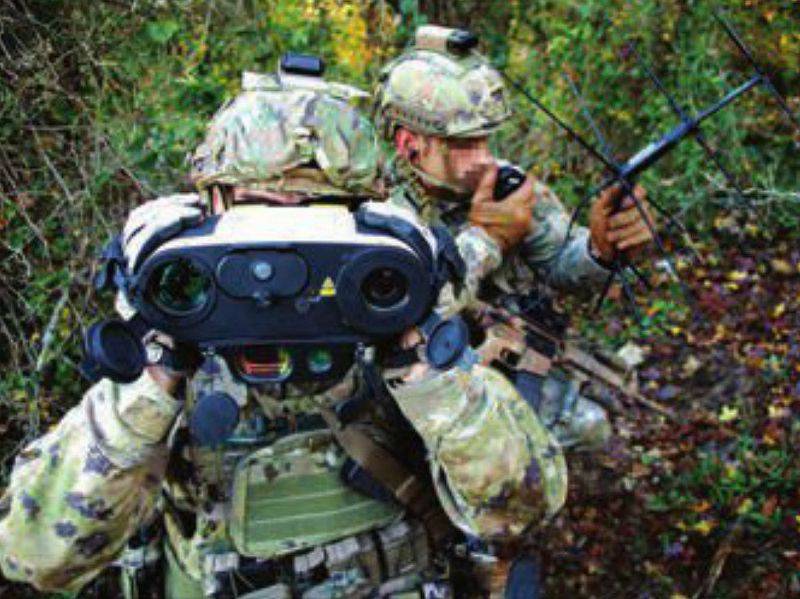
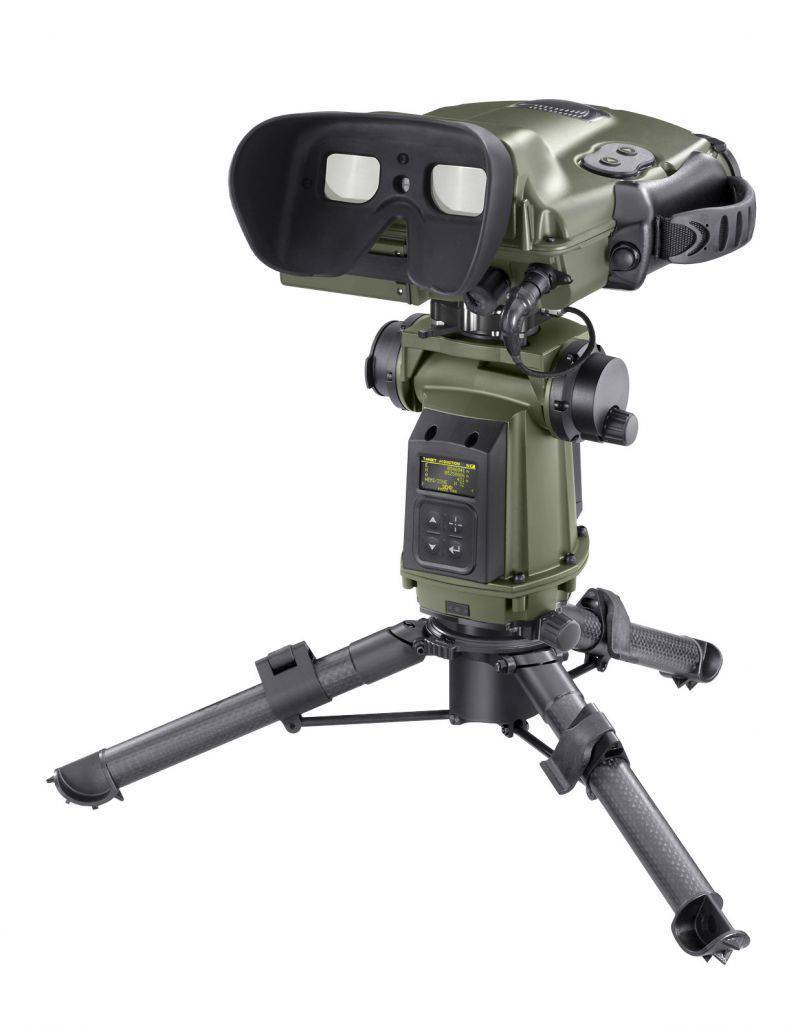
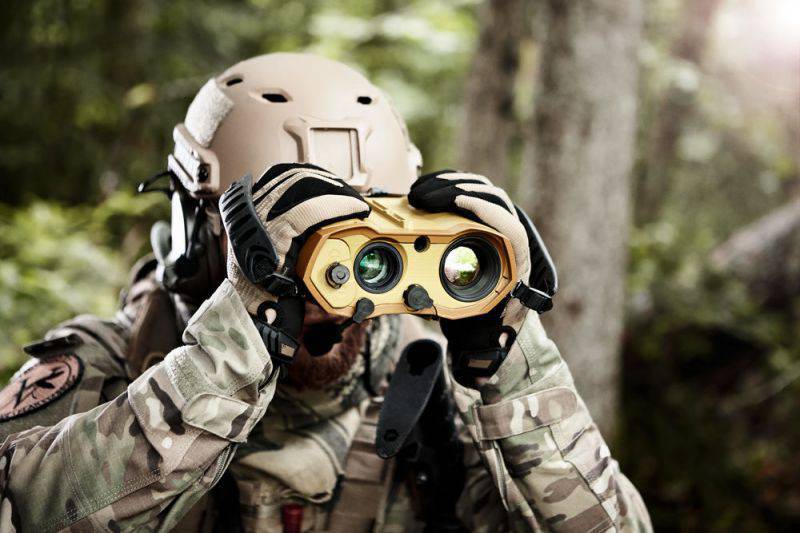
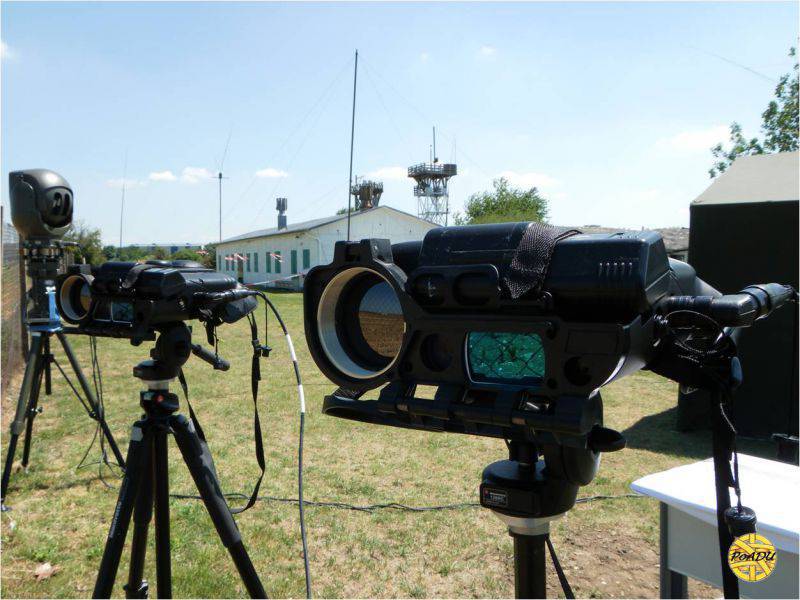
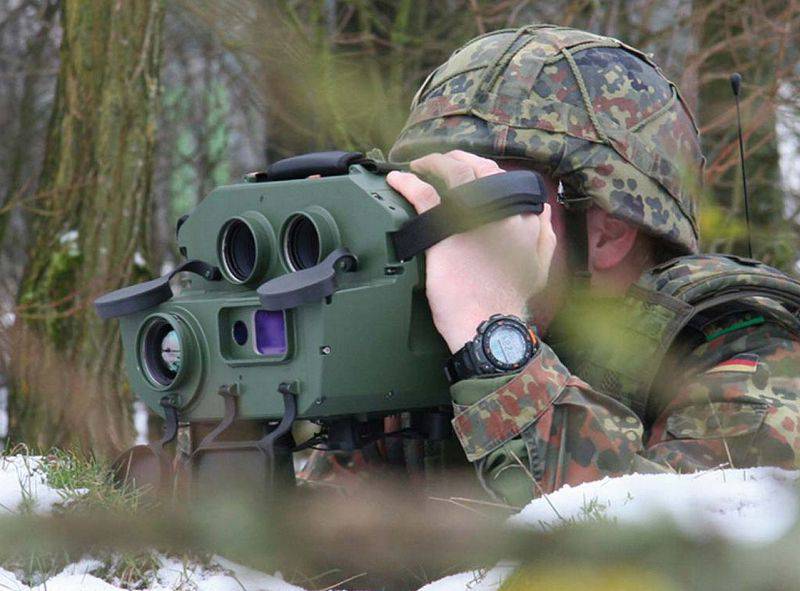
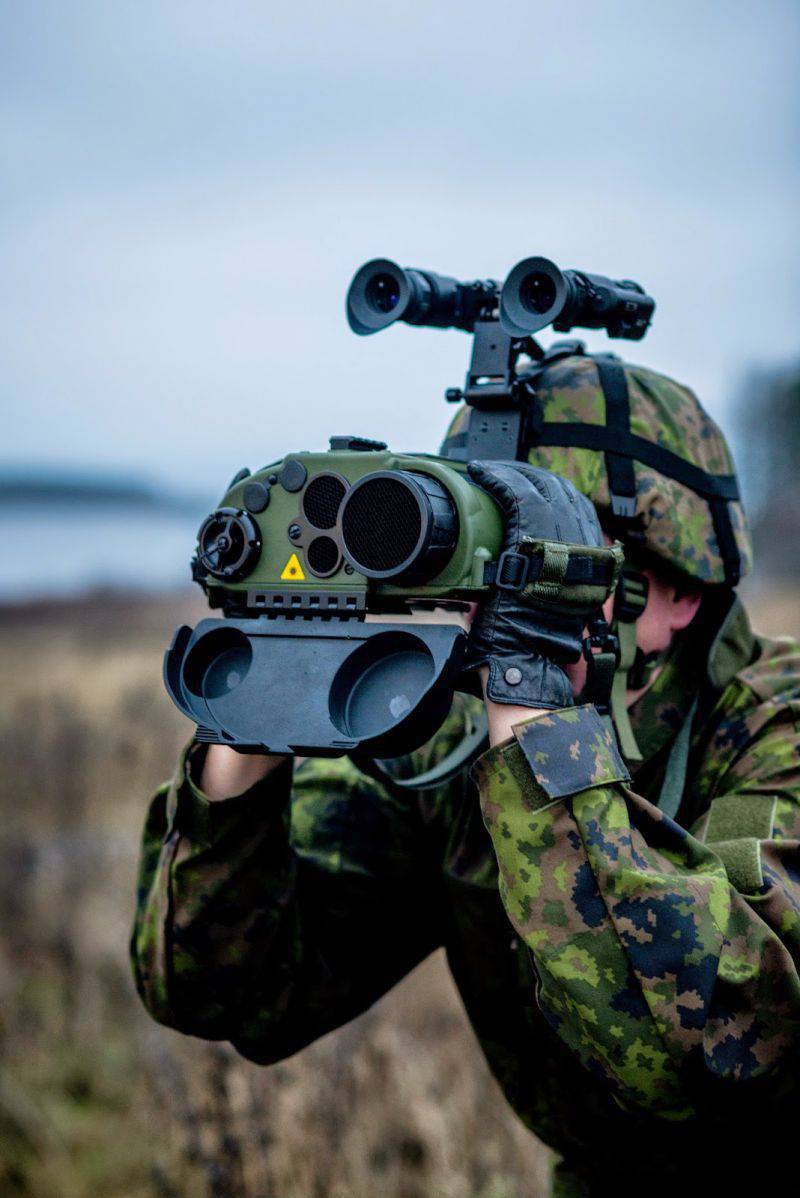
Information